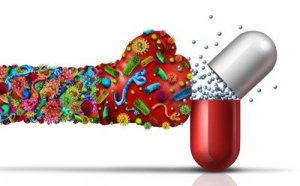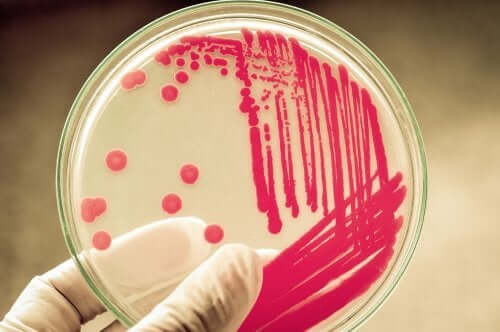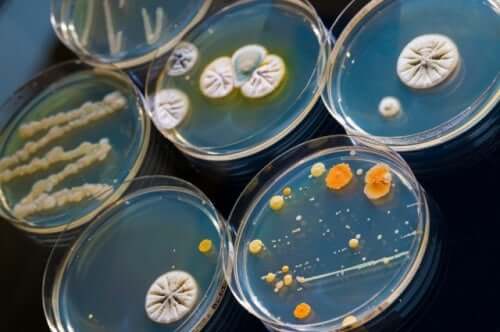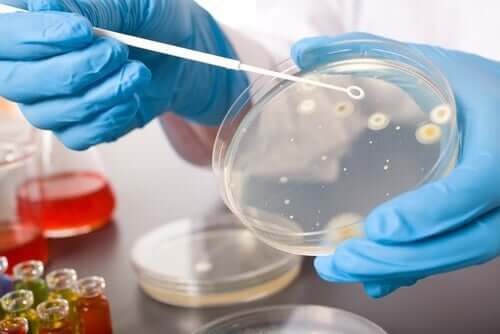What are Antimicrobials?

Antimicrobials are drugs that have the ability to stop the growth of different microorganisms. Typically, a certain antimicrobial will be effective depending on the type of microorganism. In this regard, there are different effective antimicrobials out there that fight against bacteria, fungi, or parasites.
Throughout this article, we’ll take a look at the different types of antimicrobials, their uses, and their main characteristics.
Type of antimicrobials

Overall, these drugs can be classified based on two aspects:
- First, their mechanism of action.
- Second, the type of microorganism.
Classification of antimicrobials according to their mechanism of action
First, according to this classification, we can distinguish the following antimicrobials:
- Sterilizers.
- Disinfectants.
- Antiseptics or chemotherapeutics.
Let’s take a look at all three of these.
Sterilizers
Sterilizers are capable of killing any type of microorganism. Two of the best-known sterilizers are glutaraldehyde and ethylene oxide.
Moreover, physical methods such as heat, filtration, and ionizing radiation are also used for this purpose.
Disinfectants
Next, doctors use disinfectants to kill microorganisms on inert materials. This is due to the toxic effects they usually cause on living tissue. Overall, some of the most-used disinfectants are alcohol and iodine compounds such as Betadine.
It’s important to differentiate disinfection from sterilization. Unlike sterilizers, disinfectants aren’t able to completely kill microorganisms.
Antiseptics and chemotherapeutics
Both of these have similar uses. However, one difference between them is that antiseptics are applied directly to damaged tissue to prevent microorganism growth. On the other hand, they administer chemotherapeutics intravenously.
Classification of antimicrobials according to the type of microorganism
Below, we’ll classify antimicrobials according to the microorganisms they act against.
Antibiotics

The term antibiotic refers to a chemical that kills or inhibits the growth of certain types of sensitive microorganisms.
As their name suggests, doctors use antibiotics to treat bacterial infections. Medical professionals use these drugs both in veterinary and human medicine. Plus, they do this along with antiparasitics and other antimicrobials. Overall, the goal of treatment with antibiotics is to kill the microorganism.
Finally, it’s important to mention that self-medication with antibiotics is a serious public health problem. The reason for this is that bacteria are able to develop resistance mechanisms to different antibiotics. Thus, the initially effective treatments fail to work and the antibiotics become ineffective.
Antifungals
These are also called antimycotics. Overall, they’re substances that stop the growth of or kill certain fungi.
Like antibiotics, many people self-medicate and abuse these drugs. Unfortunately, this causes microorganisms to develop resistance against common drugs.
Here are some of the best-known antifungals:
- Itraconazole
- Posaconazole
- Fluconazole
- Voriconazole
- Caspofungin
Antiparasitics

Next, these antimicrobials are used both in veterinary and human medicine. They fight infections caused by bacteria and parasites. Plus, they also use them for the treatment of some types of cancer.
Overall, the best-known antiparasitics are anthelmintics and antiprotozoals, such as:
- Albendazole
- Mebendazole
- Trimethoprim
- Paromomycin
- Metronidazole
- Ivermectin
Today, scientists are trying to discover other antiparasitics with fewer adverse effects. In addition, they’re also trying to fight the development of parasite resistance to commercial drugs.
Discover: A Milk and Mint Remedy to Fight Intestinal Parasites
Antivirals
Next, medical professionals use these drugs to treat viral infections. Unfortunately, they aren’t able to cure the disease. However, they can alleviate the symptoms.
Thus, they’re able to reduce the severity of symptoms and the likeliness of suffering complications. Overall, antivirals exist for each type of virus. However, doctors have to prescribe them to patients.
Conclusion
Overall, antimicrobial substances are capable of inhibiting the growth of or killing various microorganisms. Doctors use one type or another depending on the particular infection and situation.
Microbial drugs (antibacterials, antifungals, antiparasitics, and antivirals) aren’t available without a prescription. Therefore, self-medicating with these types of drugs favors the development of microorganism resistance. Thus, it can make treatment less effective for everyone.
All cited sources were thoroughly reviewed by our team to ensure their quality, reliability, currency, and validity. The bibliography of this article was considered reliable and of academic or scientific accuracy.
- Melo. (2012). Guia de Antimicrobianos. Hospital Das Clinicas Da Universidade Federal de Goias HC-UFG. https://doi.org/10.1109/CGO.2007.32
- Arias, M. V. B., & De Maio Carrilho, C. M. D. (2012). Resistência antimicrobiana nos animais e no ser humano. Há motivo para preocupação? Semina:Ciencias Agrarias. https://doi.org/10.5433/1679-0359.2012v33n2p775
- Melo, V. V., Duarte, I. D. P., & Soares, A. Q. (2012). Guia Antimicrobianos. Coordenaçao de Farmacia – Hospital das Clinicas da Universidade Federal de Goiás (HC – UFG).
This text is provided for informational purposes only and does not replace consultation with a professional. If in doubt, consult your specialist.








